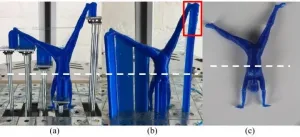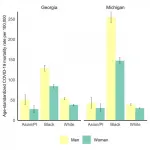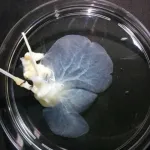(Press-News.org) 3-D printing has the potential to revolutionize product design and manufacturing in a vast range of fields--from custom components for consumer products, to 3-D printed dental products and bone and medical implants that could save lives. However, the process also creates a large amount of expensive and unsustainable waste and takes a long time, making it difficult for 3-D printing to be implemented on a wide scale.
Each time a 3-D printer produces custom objects, especially unusually-shaped products, it also needs to print supports-printed stands that balance the object as the printer creates layer by layer, helping maintain its shape integrity. However, these supports must be manually removed after printing, which requires finishing by hand and can result in shape inaccuracies or surface roughness. The materials the supports are made from often cannot be re-used, and so they're discarded, contributing to the growing problem of 3-D printed waste material.
For the first time, researchers in USC Viterbi's Daniel J. Epstein Department of Industrial and Systems Engineering have created a low-cost reusable support method to reduce the need for 3-D printers to print these wasteful supports, vastly improving cost-effectiveness and sustainability for 3-D printing.
The work, led by Yong Chen, professor of industrial and systems engineering and PhD student Yang Xu, has been published in Additive Manufacturing.
Traditional 3-D printing using the Fused Deposition Modeling (FDM) technique, prints layer-by-layer, directly onto a static metal surface. The new prototype instead uses a programmable, dynamically-controlled surface made of moveable metal pins to replace the printed supports. The pins rise up as the printer progressively builds the product. Chen said that testing of the new prototype has shown it saves around 35% in materials used to print objects.
"I work with biomedical doctors who 3-D print using biomaterials to build tissue or organs," Chen said. "A lot of the material they use are very expensive-we're talking small bottles that cost between $500 to $1000 each."
"For standard FDM printers, the materials cost is something like $50 per kilogram, but for bioprinting, it's more like $50 per gram. So if we can save 30% on material that would have gone into printing these supports, that is a huge cost saving for 3-D printing for biomedical purposes," Chen said.
In addition to the environmental and cost impacts of material wastage, traditional 3-D printing processes using supports is also time-consuming, Chen said.
"When you're 3-D printing complex shapes, half of the time you are building the parts that you need, the other half of the time you're building the supports. So with this system, we're not building the supports. Therefore, in terms of printing time, we have a savings of about 40%."
Chen said that similar prototypes developed in the past relied on individual motors to raise each of the mechanical supports, resulting in highly energy-intensive products that were also much more expensive to purchase, and thus not cost-effective for 3-D printers.
"So if you had 100 moving pins and the cost of every motor is around $10, the whole thing is $1,000, in addition to 25 control boards to control 100 different motors. The whole thing would cost well over $10,000."
The research team's new prototype works by running each of its individual supports from a single motor that moves a platform. The platform raises groups of metal pins at the same time, making it a cost-effective solution. Based on the product design, the program's software would tell the user where they need to add a series of metal tubes into the base of the platform. The position of these tubes would then determine which pins would raise to defined heights to best support the 3-D printed product, while also creating the least amount of wastage from printed supports. At the end of the process, the pins can be easily removed without damaging the product.
Chen said the system could also be easily adapted for large scale manufacturing, such as in the automotive, aerospace and yacht industries.
"People are already building FDM printers for large size car and ship bodies, as well as for consumer products such as furniture. As you can imagine, their building times are really long--we're talking about a whole day," Chen said. "So if you can save half of that, your manufacturing time could be reduced to half a day. Using our approach could bring a lot of benefits for this type of 3-D printing."
Chen said the team had also recently applied for a patent for the new technology. The research was co-authored by Ziqi Wang, previously a visiting student at USC, from the School of Computer and Communication Sciences, EPFL Switzerland, and Siyu Gong from USC Viterbi.
INFORMATION:
Likely the first extinction event of the 2000s in Europe, the sad history of the Pyrenean Ibex (Capra pyrenaica pyrenaica) is a powerful example of the ever-increasing species loss worldwide due to causes related to human activity. It can, however, give us valuable information on what should be done (or avoided) to halt this extinction vortex.
The distribution of this subspecies of Iberian Ibex was limited to the French and Spanish Pyrenees. Its first mention in an official written document, dating back to 1767, already refers to it as extremely rare. Like many other mountain goats, it was almost hunted to extinction before its killing became prohibited in 1913. Neither the institution ...
Insomnia is a common problem in patients with schizophrenia, and a new study reinforces a close association between insomnia, more suicidal thoughts and actions and increased problems like anxiety and depression in these patients.
It also provides more evidence that keeping tabs on how patients are sleeping -- and intervening when needed -- is important to their overall care.
"We are now aware that significant insomnia is putting our patients at even higher risk for suicide, so if they are having changes in sleep patterns, if they are having significant insomnia, then we really need to hone in on those questions even more related to suicidal thinking and do what we can to help," says Dr. ...
A new paper in the Journal of General Internal Medicine published by the GenderSci Lab at Harvard University shows that Black women are dying at significantly higher rates than white men, and that disparities in mortality rates among women of all races are greater than those between white women and white men.
The study is the first to quantify the inequities in COVID-19 mortality looking at both race and sex group.
"This analysis complicates the simple narrative that men are dying at greater rates of COVID-19 than women," said lead author Tamara Rushovich, Harvard Ph.D. candidate in population health sciences and lab member ...
The adult human body produces hundreds of billions of blood cells every day. This essential process unavoidably leads to the appearance of mutations in the DNA of the progenitor cells. These are known as somatic mutations because they are acquired, not inherited. While most of these mutations are innocuous, occasionally a mutation gives affected cells a competitive advantage that allows them to expand progressively, generating clonal populations of blood cells. This phenomenon is known as clonal hematopoiesis.
Now, a team of scientists at the Centro Nacional de Investigaciones Cardiovasculares (CNIC) and the Hospital Universitario Virgen de Arrixaca in Murcia has discovered that the presence of these acquired mutations in blood cells increases ...
Below please find summaries of new articles that will be published in the next issue of Annals of Internal Medicine. The summaries are not intended to substitute for the full articles as a source of information. This information is under strict embargo and by taking it into possession, media representatives are committing to the terms of the embargo not only on their own behalf, but also on behalf of the organization they represent.
1. ACP Best Practice Advice: Shorter course of antibiotics may be appropriate for some common infections
HD video soundbites of ACP's president discussing the paper are available to download at http://www.dssimon.com/MM/ACP-antibiotics-paper.
Abstract: https://www.acpjournals.org/doi/10.7326/M20-7355
Free ...
Researchers at the Human Genome and Stem Cell Research Center (HUG-CELL), hosted by the University of São Paulo's Institute of Biosciences (IB-USP) in Brazil, have developed a technique to reconstruct and produce livers in the laboratory.
The proof-of-concept study was conducted with rat livers. In the next stage of their research, the scientists will adapt the technique for the production of human livers in order in future to increase the supply of these organs for transplantation.
The study was supported by FAPESP and is reported in an article published in Materials Science and Engineering: ...
PITTSBURGH, April 5, 2021 - "Near-poor" Americans--people just above the federal poverty level but still well below the average U.S. income--who rely on Medicare for health insurance face high medical bills and may forgo essential health care, according to new research led by health policy scientists at the University of Pittsburgh Graduate School of Public Health. This is due to a coverage "cliff" in Medicaid, which supplements Medicare for people with incomes below poverty but excludes individuals above the federal poverty threshold, including the near-poor.
In a report published today in the April issue of the journal Health Affairs, the authors describe the effects of this cliff and propose solutions to fix it, with the aim of lessening barriers to care among near-poor people ...
PHILADELPHIA-- Approximately 6.5 million people are under correctional supervision in the United States on any given day. Justice-involved individuals (people currently or recently in prison or jail, on probation or parole, or arrested) experience higher rates of substance use disorders than the general population. In fact, among people with opioid use disorder (OUD), more than half have reported contact with the criminal justice system.
Numerous clinical studies have shown that medications for OUD -- specifically, methadone or buprenorphine -- lead to superior outcomes for retention in treatment, reduced illicit opioid use, and decreased opioid-related overdose rates and serious acute care compared with treatments that ...
PHILADELPHIA-- While the emergency department (ED) functions as an integral part of the United States healthcare safety net by handling all medical complaints regardless of insurance status, ED visits are expensive, and many are for lower-acuity conditions that may be amenable to care in other settings. Previous research has suggested that greater availability of urgent care centers - freestanding facilities with extended hours that staff emergency physicians, primary care physicians, or nurse practitioners, and focus on a broad range of lower acuity complaints, like rash, muscle strain, bronchitis, and urinary tract infection - helps decrease ED visits, but whether the centers reduce or increase net spending for patients ...
Even before the pandemic made telehealth a hot topic, people with minor urgent health needs had started to turn to companies that offer on-demand video chats with physicians that they don't normally see.
Insurers and employers even started buying access to this direct-to-consumer form of virtual care, hoping it might reduce in-person care, including emergency department visits.
But a new University of Michigan study casts some doubt on whether that will actually happen.
Published in the April issue of Health Affairs, the study finds that patients who had an on-demand ...





